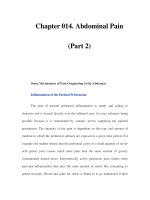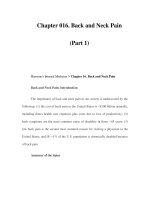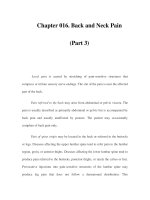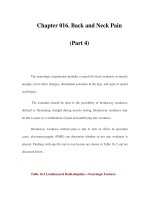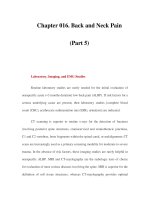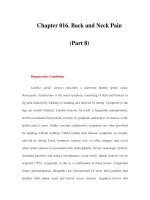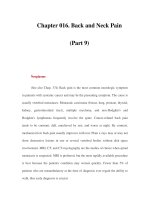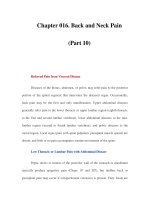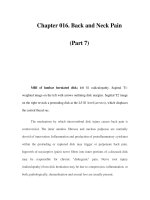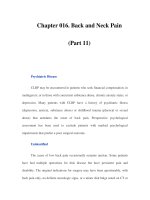Chapter 016. Back and Neck Pain (Part 2) doc
Bạn đang xem bản rút gọn của tài liệu. Xem và tải ngay bản đầy đủ của tài liệu tại đây (939.42 KB, 6 trang )
Chapter 016. Back and Neck Pain
(Part 2)
The posterior portion of the spine consists of the vertebral arches and seven
processes. Each arch consists of paired cylindrical pedicles anteriorly and paired
laminae posteriorly. The vertebral arch gives rise to two transverse processes
laterally, one spinous process posteriorly, plus two superior and two inferior
articular facets. The apposition of a superior and inferior facet constitutes a facet
joint. The functions of the posterior spine are to protect the spinal cord and nerves
within the spinal canal and to stabilize the spine by providing sites for the
attachment of muscles and ligaments. The contraction of muscles attached to the
spinous and transverse processes produces a system of pulleys and levers that
results in flexion, extension, and lateral bending movements of the spine.
Nerve root injury (radiculopathy) is a common cause of neck, arm, low
back, and leg pain (Figs. 25-2 and 25-3). The nerve roots exit at a level above their
respective vertebral bodies in the cervical region (the C7 nerve root exits at the
C6-C7 level) and below their respective vertebral bodies in the thoracic and
lumbar regions (the T1 nerve root exits at the T1-T2 level). The cervical nerve
roots follow a short intraspinal course before exiting. By contrast, because the
spinal cord ends at the vertebral L1 or L2 level, the lumbar nerve roots follow a
long intraspinal course and can be injured anywhere from the upper lumbar spine
to their exit at the intervertebral foramen. For example, disk herniation at the L4-
L5 level commonly produces compression of the traversing S1 nerve root (Fig. 16-
3).
Figure 16-3
Pain-sensitive structures in the spine include the periosteum of the
vertebrae, dura, facet joints, annulus fibrosus of the intervertebral disk, epidural
veins, and the posterior longitudinal ligament. Disease of these diverse structures
may explain many cases of back pain without nerve root compression. The
nucleus pulposus of the intervertebral disk is not pain-sensitive under normal
circumstances. Pain sensation is conveyed partially by the sinuvertebral nerve that
arises from the spinal nerve at each spine segment and reenters the spinal canal
through the intervertebral foramen at the same level. The lumbar and cervical
spine possess the greatest potential for movement and injury.
Approach to the Patient: Back Pain
Types of Back Pain
Understanding the type of pain experienced by the patient is the essential
first step. Attention is also focused on identification of risk factors for serious
underlying diseases; the majority of these are due to radiculopathy, fracture,
tumor, infection, or referred pain from visceral structures (Table 16-1).
Table 16-1 Acute Low Back Pain: Risk Factors for an Important
Structural Cause
History
Pain worse at rest or at night
Prior history of cancer
History of chronic infection (esp. lung, urinary tract, skin)
History of trauma
Incontinence
Age > 50 years
Intravenous drug use
Glucocorticoid use
History of a rapidly progressive neurologic deficit
Examination
Unexplained fever
Unexplained weight loss
Percussion tenderness over the spine
Abdominal, rectal, or pelvic mass
Patrick's sign or heel percussion sign
Straight leg or reverse straight-leg raising signs
Progressive focal neurologic deficit
